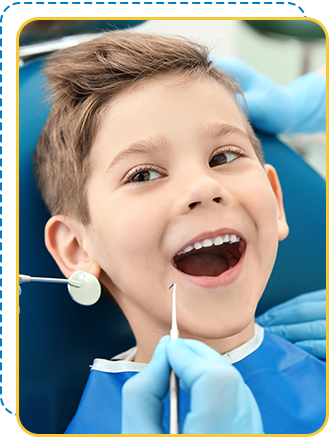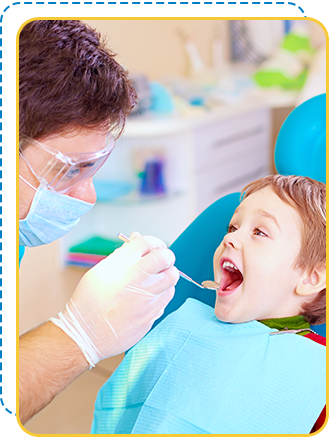First Visit
At your child’s first visit we will introduce your Child to the concepts of preventive dental care. At every exam we will review your child’s health history; take any necessary x-rays; clean your child’s teeth; conduct a thorough clinical examination of your child’s mouth, palate, gums, tongue and teeth.
You are welcome to stay with your child during each appointment, although most patients do better without a parent present, we trust you know your child and what is best for them. We have found that without a parent present it is much easier for our team to establish a relationship and communicate with your child. If you choose, you are more than welcome to accompany your child to the treatment room. We ask that only one parent accompany each patient, and that siblings without appointments remain in the waiting room with a trusted adult.


Dental Sealants
Dental sealant is a plastic resin that bonds to the deep grooves in the tooth’s chewing surface. When sealing a tooth, the grooves of the teeth are filled and the tooth surface becomes smoother and less likely to harbor plaque. With sealants, tooth brushing becomes easier and more effective against tooth decay.
Sealants are applied to children’s teeth as a preventive measure and can be useful not only throughout childhood but as an adult as well. It is common to see adults with intact sealants from childhood. Sealants are checked during your child’s dental checkup to ensure that they continue providing protection through the years. Every child has unique needs and sealants will be recommend on a case by case basis.
Cavities “Sugar Bugs”
If your child has a cavity, it typically will need to be filled. Cavities that have time to grow can become infected. Infected primary or “baby” teeth can affect the developing permanent teeth and cause serious health complications. Some parents will ask, “If this is a baby tooth, why do we need to fill it? Can’t we just take it out?” If a baby tooth has a cavity, and the cavity will become infected before the tooth will fall out, then that tooth will need to be restored with a filling. If a baby tooth is due to fall out within the next year and it has a cavity; that is a situation where extracting the tooth would be considered rather than doing a filling. Taking baby teeth out years before they are meant to naturally fall out may cause costly orthodontic complications for your child later in life. Each case is unique and we are happy to discuss treatment options with you to find the best solution for your child.

Dental Emergencies:
We understand emergencies happen.
When they do, it’s nice to know that you have a Dentist to call anytime if you are a patient of record at our office.
Inhalation Sedation
Inhalation sedation is the mildest form of sedation. This method utilizes Nitrous Oxide (laughing gas) and Oxygen to help your child’s body achieve a relaxed state. Your child remains awake and aware but is more inclined to relax. This form of sedation is referred to as anxiolytic sedation and is not meant to overcome severe anxiety. This is a very safe way of giving your child a pleasant dental experience and is the most popular form of sedation used in dentistry today.

Why doesn’t our office utilize
Oral Sedation?
Oral sedation is a technique in which the dentist gives your child an oral medication to sedate or relax your child. Because the medication is given orally it is difficult to predict the level of relaxation your child may reach. It can range from a mild sedation similar to levels reached with nitrous oxide or a deeper form of sedation and thus may differ for each patient. Because of this not all patients may reach an adequate level of sedation to accomplish the restorative care they may need. Because the medication is given orally the dosage cannot be changed once it is given. If the patient does reach an adequate level of sedation to successfully perform a complex dental procedure the patient will require close monitoring. Though the state allows a dentist to orally sedate a child, monitor that child, and perform the dentistry at the same time; Dr. Thomas feels it is best to have a separate Doctor whose sole purpose and attention is devoted to monitoring your child during the procedure. The cost of providing this service is worth the extra safety it provides your child.

Why doesn’t our office utilize
Oral Sedation?
Oral sedation is a technique in which the dentist gives your child an oral medication to sedate or relax your child. Because the medication is given orally it is difficult to predict the level of relaxation your child may reach. It can range from a mild sedation similar to levels reached with nitrous oxide or a deeper form of sedation and thus may differ for each patient. Because of this not all patients may reach an adequate level of sedation to accomplish the restorative care they may need. Because the medication is given orally the dosage cannot be changed once it is given. If the patient does reach an adequate level of sedation to successfully perform a complex dental procedure the patient will require close monitoring. Though the state allows a dentist to orally sedate a child, monitor that child, and perform the dentistry at the same time; Dr. Thomas feels it is best to have a separate Doctor whose sole purpose and attention is devoted to monitoring your child during the procedure. The cost of providing this service is worth the extra safety it provides your child.
Special Anesthesia Services Charges
Some charges will be covered by insurance. Many times, medical insurance will pay the anesthesia charges for children under the age of six, patients with a mental or physical handicap, or patients with a medical necessity. We participate with many of the most popular insurance plans and will work with your insurance company and you to provide your child with care. We can do a predetermination with your insurance company to find out if your policy provides coverage for our services.
Other insurance plans will do predetermination, but we don’t do these through our office. Our staff will be glad to assist you with the information you’ll need when contacting your insurance company to determine if your child will be covered. You can usually accomplish the predetermination over the phone, but we suggest you have your insurance company send you a letter of confirmation.

Contact Us


